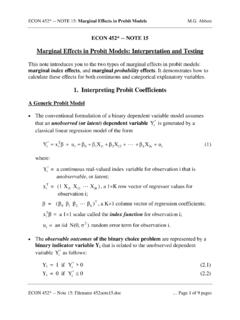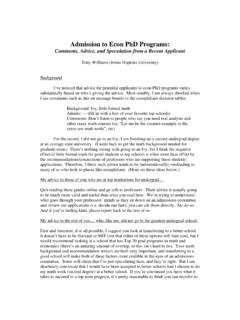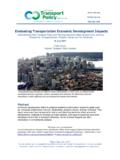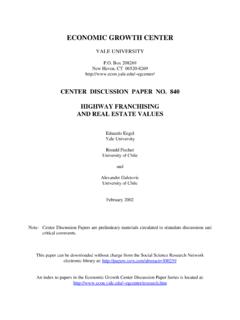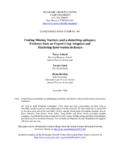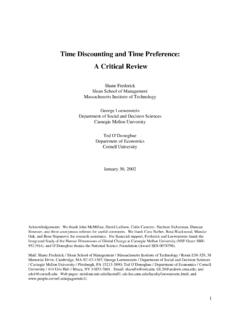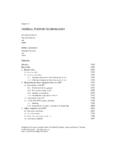Transcription of ECONOMICS 452 TIME SERIES WITH STATA
1 1. ECONOMICS 452. time SERIES with STATA . Introduction This manual is intended for the first half of the ECONOMICS 452 course and introduces some of the time SERIES capabilities in STATA 8. I will be writing programs and fixing others throughout the term so this is really just a manual to get started. Other details will follow. STATA has an excellent online help facility and there are manuals available. The emphasis in this outline is on time SERIES in STATA (note: earlier versions of STATA did not do time SERIES analysis). If you have never used STATA before, it would be a good idea to get the tutorial manual for ECONOMICS 351 which goes over the basics for using STATA ( ).
2 Keep in mind that the principal di erence between cross-section and time SERIES data is that order matters in the latter. We cannot shu e the data as we did, say in a cross-section, using perhaps a sort command. The calendar time gives us the order of the variables and it makes no sense to mix this up. We often wish to create leads or lags of certain variables and STATA needs to know what variable in our set it should identify with the time (much more on this below). Once the time variable is identified, STATA can construct leads or lags in a logical manner. There are many sources for time SERIES data (for example you probably have downloaded some from the CANSIM databank in one of your courses).
3 Starting STATA Double click on the STATA icon. The first screen you will see contains four STATA windows: The STATA Command window, in which you type all STATA commands. The STATA Results window, which displays the results of each STATA command as you enter it. The Review window, which displays the past commands you have issued during the current STATA session. The Variables window, which lists the variables in the currently-loaded data file. There are a number of programs (called ado files) that I have written for STATA for the Econ 452 ( time SERIES ) course. To ensure you have the latest of these type: Qprofile and then check Econ452 dialog box that appears.
4 This will 2. automatically download the most recent ado files (creating directories where they do not exist) onto the hardrive and make them accesible to you put you in the appropriate directory for using my demo programs (re- ferred to in the chapters and in theis manual). To get out of the QED session, you will need to type: BREAK (all capitals). Log File As you work in STATA , be sure to make a record of your session by creating a log' file In a STATA do file (explained later) type: log using a:\logfile,replace text (the replace writes over any existing file so if you do not want that change the name and the text command writes the file in an ordinary and readable text file).
5 Alternatively, open the log file by clicking on the Log button which is the fourth from the top left corner (chose .log option and not .smcl) . Name the file and change directory to a:\ .(if using a diskette). You should always open a log file before you type any commands in STATA , and close it at the end of your Always save files to your diskette, usb datakey or the temporary directory on c:\temp which you can e-mail to yourself at the end of the session. Files left on public sites tend to disappear. At the end of your session type : log close or click on the same button to close the log file. Help in STATA There are three useful ways to get online help.
6 Suppose you want to use the generate command but forget its syntax. 1. You can type: help generate 2. Another neat way to find out stu is to use the search command. For instance I might want to know about all the di erent appearances of generate , so we could type: search generate. This will generate all kinds of information that you could follow up on. 3. In STATA 9, there are drop down dialogue boxes for all the commands. READING IN DATA 3. Reading in Data There are several types of data sets that STATA can use: 1. STATA data sets usually identified with a .dta su x 2. ASCI data sets or flat files (this is what most of the CANSIM and Journal of Applied Econometric data sets are in) and usually has an extension.
7 Raw 3. Others kinds (like Excel spreadsheets) can be read in but typically it is easier to paste data in this format directly into the STATA editor and save! Eventually, you will want to convert any ASCI datafile to a STATA datafile, since this can be read in faster to STATA than flat files and will save any labels or other information that we have created. We will show how to do this later in the tutorial. One other advantage of a STATA datafile is the you can simply click on the datafile and it will open directly into STATA . Suppose you have just downloaded a Journal of Applied Econometrics dataset and want to read it into STATA . Since it is not a STATA datafile you will have to let STATA know how to read it.
8 To keep things simple, let us assume that you have 200. observations on a variable temperature (called temp) stored on your diskette with the name: This is an ASCI datafile. To load the variable temp into STATA , we use the infile command.. infile temp using a:\bntemp STATA will reply (200 observations read). Notice that we left o the extension .raw since this is assumed by STATA . If instead our file was called , we would write . infile temp using a:\ Now that we have loaded the data into STATA we might just start to analyze the data, create new variables and so on. Imagine that we have done this and created several new variables and we wish to save the entire dataset as a STATA datafile.
9 This is easily done by typing . save _all using a:\bntemp 4. This will create a STATA datafile (called ) on our a directory (we use lower case letters in this manual, since all commands in STATA must be lower case). Notice we left out the .dta extension (it is the default extension). Whenever we want to use this dataset in the future, we can simply click on it with our mouse and it will open in STATA . If on another occasion we were to create new variables or add data, we can save the new dataset by writing over the old STATA dataset (we could create a new dataset by using another name too) by typing save _all using a:\bntemp,replace Now part of the first project involves calculating descriptive statistics of your data set.
10 This can be accomplished by using the summarize command. If you do not specify a particular variable, STATA will summarize the entire dataset. Again we will assume that we have only one variable called temp.. summarize Variable | Obs Mean Std. Dev. Min Max ---------+------------------------------ ----------------------- temp | 200 If you want more descriptive statistics (percentiles, kurtosis, skewness and so on). type . summarize temp, detail To have your data listed type list . list temp 1. 2. 3.. 198. 199. 200. Creating a time variable Often when we download data, there will be a variable that identifies the time frequency of the variable. Typically this variable would not be in the appropriate CREATING A time VARIABLE 5.

